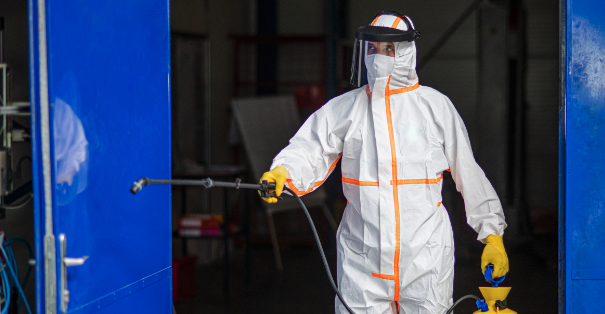SafeDE News
Smarter workplaces are safer workplaces. SafeDE is your resource for OSHA news, regulation changes, recalls, and everything to keep your business safe.
Essential Tips to Prevent Heat Illness in the Workplace
Every year, thousands of U.S. workers become sick from occupational heat exposure, with some cases proving fatal. Heat illness can develop rapidly when the body's cooling system can't keep up with high temperatures and humidity.
High-Risk Industries and Workers
Workers in certain industries face elevated risks due to physical demands and environmental exposure:
- Construction workers - Building and infrastructure projects
- Agricultural workers - Farm laborers and crop handlers
- Maintenance and utility workers - Equipment repair and infrastructure maintenance
- Landscaping professionals - Grounds keeping and outdoor maintenance
- Emergency responders - Firefighters and first responders
- Manufacturing workers - Especially those near heat-generating equipment
- Warehouse and logistics workers - Distribution centers and delivery drivers
8 Essential Prevention Strategies
1. Implement Comprehensive Management Protocols
Employers must establish robust heat illness prevention programs that include:
- Written heat illness prevention plans as may be required under emerging regulations
- Designated shaded rest areas and cooling stations
- Weather monitoring systems with trigger temperatures
- Clear emergency response procedures
- Regular safety training and refresher programs
- OSHA has conducted over 5,000 Heat National Emphasis Program Federal inspections as of June 2024, emphasizing the importance of proactive compliance
2. Educate Workers on Rights and Responsibilities
Under current and proposed regulations, workers have enhanced rights including:
- The right to report heat-related hazards without retaliation
- Access to medical records related to heat exposure
- The right to request workplace safety inspections
- Protection from working in unsafe heat conditions
- Access to adequate rest, water, and shade
3. Optimize Hydration Strategies
Current best practices for workplace hydration:
- Drink 8 ounces (1 cup) of cool water every 15-20 minutes
- Begin hydrating before work starts and continue throughout the shift
- Monitor urine color as a hydration indicator (pale yellow indicates adequate hydration)
- Provide electrolyte replacement drinks for extended or intense work periods
- Avoid caffeine, alcohol, and excessive sugar during hot weather work
- Install multiple water stations throughout work areas
4. Implement Smart Clothing and PPE Strategies
Balance safety requirements with heat protection:
- Choose moisture-wicking, breathable fabrics when possible
- Use light-colored clothing to reflect heat
- Ensure proper fit to allow air circulation
- Replace wet or soiled face coverings promptly
- Consider cooling vests or other personal cooling devices for extreme conditions
- Rotate PPE to allow drying and cooling between uses
5. Schedule Strategic Rest and Recovery
Enhanced rest break protocols:
- Mandatory rest breaks in shaded or air-conditioned areas
- Increase break frequency as temperatures rise
- Longer rest periods during peak heat hours (typically 10 AM - 4 PM)
- Cool-down areas with fans, air conditioning, or misting systems
- Flexible scheduling to avoid peak temperature periods when possible
6. Foster a Culture of Heat Safety Awareness
Create systems for peer monitoring and support:
- Implement buddy system protocols
- Train workers to recognize heat illness symptoms in themselves and others
- Establish clear reporting procedures without fear of retaliation
- Encourage open communication about heat-related concerns
- Regular safety meetings focused on heat prevention
7. Assess and Accommodate Individual Risk Factors
Recognize that heat tolerance varies significantly among individuals:
Higher risk factors include:
- Age (older workers and new employees under 25)
- Certain medications (diuretics, blood pressure medications, antidepressants)
- Chronic health conditions (diabetes, heart disease, obesity)
- Physical fitness level and acclimatization status
- Previous heat illness episodes
- Pregnancy
Accommodation strategies:
- Gradual acclimatization programs for new workers
- Modified work assignments based on individual risk assessment
- More frequent monitoring for high-risk individuals
- Alternative work schedules during extreme heat events
8. Prepare for Climate Change Impacts
Future-proofing heat safety programs:
- Monitor long-term weather patterns and heat trends
- Upgrade cooling systems and infrastructure proactively
- Develop contingency plans for extreme heat events
- Consider climate projections in facility planning
- Stay informed about evolving regulations and best practices
Emergency Response: What to Do When Heat Illness Occurs
Immediate Response Protocol
Call 911 immediately if the worker shows signs of:
- Confusion, altered mental state, or loss of consciousness
- Body temperature above 104°F (40°C)
- Seizures or slurred speech
- Rapid, weak pulse or difficulty breathing
While waiting for emergency services:
- Move the worker to the coolest available location
- Remove excess clothing and apply cool water or ice to neck, armpits, and groin
- Use fans to increase air circulation
- If conscious and able to swallow, provide cool water in small amounts
- Monitor vital signs and be prepared to perform CPR if necessary
- Never leave the worker alone
Non-Emergency First Aid
For heat exhaustion or less severe symptoms:
- Move to a cool, shaded area immediately
- Provide cool water to drink (avoid ice-cold water)
- Apply cool, wet cloths to skin
- Use fans or air conditioning to lower body temperature
- Remove tight or unnecessary clothing
- Monitor symptoms closely - call 911 if condition worsens
- Do not allow the worker to return to work until cleared by medical personnel
The Business Case for Heat Safety
Investing in comprehensive heat illness prevention delivers measurable returns:
- Reduced workers' compensation claims and medical costs
- Improved productivity and reduced absenteeism
- Enhanced employee retention and satisfaction
- Regulatory compliance and avoided penalties
- Reputation protection and risk management
Heat illness is entirely preventable with proper planning, training, and proactive safety measures. By implementing these strategies and fostering a culture of heat safety awareness, employers can significantly reduce risks while maintaining productive operations.
For more detailed information on identifying symptoms early, read our comprehensive guide on Recognizing Warning Signs of Heat Illness.
Get SafeDE News
Workplace safety for all businesses.
SafeDE provides FREE comprehensive onsite surveys for small and medium sized private sector establishments to identify potential workplace hazards, improve safety and health management systems, and assist in voluntary compliance with federal OSHA regulations.
Related News
.png)
2023 Occupational Injury, Illness, and Fatality Data
-1.png)
Crane Hand Signals: Guide to OSHA-Compliant Safety

Essential PPE for Staying Safe and Comfortable in Hot Work Environments

The 5 Rules of Effective Incident Reporting
-1.png)
Tips for Selecting the Right Hard Hat for Electrical Work
.png)
Lockout Tagout Training: Essential Safety Program
-1.png)
Preventing Ergonomic Injuries: Tips and Strategies
.png)

-1.png)
.png)

